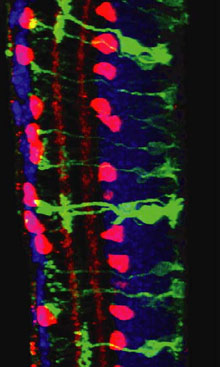Blind Mice See the Light
Blind mice developed rudimentary vision when researchers activated certain retinal cells using a gene commonly found in algae. The mice could not only sense the presence of light, but they also responded to a moving black-and-white pattern, suggesting that they could distinguish objects of a certain size.

“You wouldn’t see the very fine details, but you’d see some bigger objects,” says Botond Roska, a neurobiologist at the Friedrich Miescher Institute for Biomedical Research, in Switzerland, who led the research along with collaborators at Harvard Medical School. Their results were published online this week in Nature Neuroscience.
The mice used in the study have a form of genetically controlled blindness in which all the photoreceptor cells are missing from the retina. This condition, caused by such diseases as macular degeneration or retinitis pigmentosa, is the leading cause of blindness in humans. Because the mice’s photoreceptor cells were completely absent, the researchers targeted the next layer of cells in the visual circuit, called bipolar cells.
Usually, bipolar cells respond to light intensity. A subgroup called ON bipolar cells fires in response to light, while another subgroup, called OFF bipolar cells, shuts down in response to light. These signals work together to tell the brain about the brightness of nearby objects. In the blind mice, neither of these cell types–which normally receive their information from photoreceptor cells–can sense the presence of light.
Roska’s group targeted the ON bipolar cells, using a light-sensitive algal protein called channelrhodopsin-2 (ChR2) to confer light sensitivity where there previously was none. “Essentially, we reengineered photoreceptors into the retina,” says Roska.
The ChR2 protein embeds itself in an ON bipolar cell’s outer membrane, where it acts as a light-gated channel. When light is present, the channel opens, and positively charged ions flood into the cell. This influx of positive charge activates the cell, triggering the release of neurotransmitters and propagating the response to other nearby neurons. The net effect is that a pulse of light generates an electrical signal that makes its way through the eye and, ultimately, to the brain.
The trick was to target only ON bipolar cells. If OFF bipolar cells–or any of the many other retinal cell types–were also made light sensitive, the brain would receive mixed signals in response to light. So before injecting the ChR2 gene into the mice’s eyes, the researchers altered it with a snippet of regulatory DNA that only ON bipolar cells would respond to. That way, even though all retinal cell types took up the gene, only ON bipolar cells made the ChR2 protein.
Unlike their blind counterparts, treated mice responded to bright light by running around their cages as if to hide. And when placed on a still platform inside a rotating drum with black-and-white stripes, the treated mice followed the moving pattern. By using progressively smaller stripes, the researchers were able to gauge the limit of the mice’s ability to resolve details–it’s about half as good as that of normal mice, as it turns out.
“What was beautiful about this paper was that they were able to restore a behavioral function that was very, very clean and clear,” says Ed Boyden, an assistant professor at the MIT Media Lab, who has pioneered the use of ChR2 for bioengineering in the brain. “This is the first behavioral improvement that people have reported for the use of this gene in the visual system,” says Boyden, who was not involved in the research.
If the technique is adapted to treat blindness in humans, says Roska, the gene will likely be delivered using a virus called AAV. This virus is a common tool for human gene therapy–it was recently used to deliver a cure for an extremely rare type of human blindness–and it has proved safe and effective in a number of clinical trials. By tweaking its coat protein, researchers could potentially adapt AAV to infect only ON bipolar cells, adding another layer of specificity.
Viral delivery could amplify the technique’s effectiveness, says Roska, perhaps improving vision even more. While the technique used to administer the gene in the mouse study only affected about 10 percent of ON bipolar cells, AAV may expand the gene’s reach.
In the future, Roska and his colleagues also plan to address the other half of the bipolar circuit–the OFF bipolar cells. Recently, Boyden and others have been developing a kind of sister technique to ChR2, using a channel protein called halorhodopsin that deactivates cells in response to light. If halorhodopsin were expressed specifically in OFF bipolar cells, that component of the visual circuit could be restored as well. “That would give you kind of a push-pull control of getting information into the brain,” says Boyden.
But Roska’s group is still searching for a gene regulator specific to OFF bipolar cells so that they can target halorhodopsin with adequate specificity. “Although we have the right tool,” he says, “we don’t have the right address.”
Keep Reading
Most Popular
Large language models can do jaw-dropping things. But nobody knows exactly why.
And that's a problem. Figuring it out is one of the biggest scientific puzzles of our time and a crucial step towards controlling more powerful future models.
The problem with plug-in hybrids? Their drivers.
Plug-in hybrids are often sold as a transition to EVs, but new data from Europe shows we’re still underestimating the emissions they produce.
Google DeepMind’s new generative model makes Super Mario–like games from scratch
Genie learns how to control games by watching hours and hours of video. It could help train next-gen robots too.
How scientists traced a mysterious covid case back to six toilets
When wastewater surveillance turns into a hunt for a single infected individual, the ethics get tricky.
Stay connected
Get the latest updates from
MIT Technology Review
Discover special offers, top stories, upcoming events, and more.